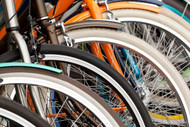The Different Types of Bikes: Choosing the Right One for You
Posted by 1UP USA on Oct 6th 2025

THE DIFFERENT TYPES OF BIKES: CHOOSING THE RIGHT ONE FOR YOU
With so many options available, finding the perfect bike can feel overwhelming. From sleek road bikes to rugged mountain bikes, each type serves a specific purpose and riding style. This guide breaks down the different types of bikes to help you make a decision that matches your cycling goals and lifestyle.
ROAD BIKES: BUILT FOR SPEED AND DISTANCE
Road bikes are designed for smooth pavement and long-distance riding. These lightweight machines feature narrow tires, drop handlebars, and an aerodynamic riding position that helps you cut through wind resistance.
KEY FEATURES OF ROAD BIKES
• Lightweight frame geometry optimized for speed
• Narrow tires (often 23–32mm) for reduced rolling resistance
• Drop handlebars for multiple hand positions
• Caliper brake or disc brake systems
• Multiple gears for tackling steep hills
Road bikes excel on bike lanes and paved surfaces, making them perfect for time trials, group rides, and commuting on smooth roads. The aggressive riding position puts you in an aerodynamic stance, though it may take time to get comfortable if you're new to cycling.
MOUNTAIN BIKES: CONQUERING ROUGH TERRAIN
Mountain bikes are built to handle unpaved roads, rocky trails, and challenging off-road conditions. These sturdy machines feature wider tires, flat handlebars, and suspension systems to absorb impacts from rough terrain.
MOUNTAIN BIKE VARIATIONS:
Type | Front Suspension | Rear Suspension | Best For |
Hardtail | Yes | No | Cross-country, beginners |
Full Suspension | Yes | Yes | Technical trails, downhill |
Fat Bike | Optional | Optional | Sand, snow, extreme conditions |
Hardtail mountain bikes offer a good balance of efficiency and comfort, while full-suspension models provide maximum control on technical terrain. Mountain bikers often prefer hydraulic disc brakes for reliable stopping power in muddy or wet conditions.
The frame geometry on mountain bikes positions riders more upright than road bikes, offering better visibility and control on challenging trails. Wider tires with aggressive tread patterns grip loose surfaces, while the lower gear ratios help you climb steep hills with heavy loads of gear.
HYBRID BIKES: THE BEST OF BOTH WORLDS
Hybrid bikes combine features from road and mountain bikes, creating versatile machines suitable for various riding conditions. They typically feature flat handlebars for comfortable control and medium-width tires that handle both pavement and light off-road terrain.
WHY CHOOSE A HYBRID BIKE:
• Comfortable upright riding position
• Versatile tire width for mixed surfaces
• Simple gear systems for easy maintenance
• Often includes mounting points for racks and fenders
• Great for casual riders and short commutes
Hybrid bikes work well for recreational cycling, light commuting, and riders who want one bike for multiple purposes. They're not as fast as road bikes on pavement or as capable as mountain bikes on rough terrain, but they offer a practical middle ground.
ELECTRIC BIKES: PEDAL-ASSISTED POWER
Electric bikes, or e-bikes, feature an electric motor that assists your pedaling effort. This technology has revolutionized cycling by making longer distances and steep hills accessible to more riders.
TYPES OF ELECTRIC BIKES
• Electric road bikes: Speed and efficiency with motor assistance
• Electric mountain bikes: Tackle tough climbs and extend trail rides
• Electric cargo bikes: Haul heavy loads with ease
• Electric city bikes: Perfect for urban commuting
The electric motor typically assists up to 20 mph (Class 1 & 2) or 28 mph (Class 3, where legal in your state). Battery range varies widely, but most modern e-bikes can handle 20-60 miles on a single charge. The added weight of the motor and battery affects handling, but the convenience often outweighs this consideration.
GRAVEL BIKES: ADVENTURE-READY VERSATILITY
Gravel bikes bridge the gap between road and mountain bikes, designed specifically for gravel roads and mixed-surface adventures. These bikes feature wider tires than traditional road bikes, but maintain the drop handlebars and efficient riding position.
GRAVEL BIKE CHARACTERISTICS:
• Wider tires (35-50mm) for stability on loose surfaces
• Relaxed frame geometry for comfort on long rides
• Disc brake systems for reliable stopping
• Multiple mounting points for bikepacking gear
• Lower gear ratios for climbing with loaded panniers
Gravel bikes excel on unpaved roads, fire roads, and light singletrack trails. They're becoming increasingly popular for bikepacking adventures and riders who want to explore beyond paved surfaces without the weight and complexity of a full mountain bike.
CARGO BIKES: HAULING MADE SIMPLE
Cargo bikes are designed to carry heavy loads while maintaining stability and control. These practical machines come in various configurations, from front-loading boxes to extended rear platforms.
CARGO BIKE STYLES:
• Longtail: Extended rear end for cargo and passengers
• Front-load: Large box or platform in front of the rider
• Trike: Three wheels for maximum stability
Many cargo bikes now feature electric motors to help with the extra weight. They're becoming popular alternatives to cars for families and businesses that need to transport goods efficiently through urban areas.
BMX BIKES: BUILT FOR TRICKS AND SPEED
BMX bikes, short for bicycle motocross, are compact machines designed for stunts, racing, and skate park riding. These bikes feature small frames, 20-inch wheels, and single-speed drivetrains for simplicity and strength.
BMX APPLICATIONS:
• Racing: High-speed competition on dirt tracks
• Freestyle: Tricks and stunts in parks or streets
• Flatland: Technical maneuvers on smooth surfaces
BMX bikes prioritize strength and maneuverability over comfort or efficiency. The small size and responsive handling make them perfect for quick acceleration and precise control during tricks.
CITY BIKES AND COMMUTER BIKES: URBAN TRANSPORTATION
City bikes and commuter bikes are designed for practical urban transportation. These bikes often feature upright riding positions, fenders, lights, and storage solutions for daily use.
COMMUTER BIKE FEATURES:
• Comfortable, upright riding position
• Internal hub gears for low maintenance
• Integrated lights and reflectors
• Fenders and chain guards for weather protection
• Mounting points for racks and panniers
Some commuter bikes use rim brakes or cantilever brake systems for simplicity, though disc brakes are now the standard on higher-quality commuter bikes. The focus is on reliability and ease of use rather than performance.
CRUISER BIKES: COMFORT AND STYLE
Cruiser bikes emphasize comfort and casual riding. These bikes feature wide, comfortable seats, swept-back handlebars, and relaxed geometry that puts riders in an upright position.
CRUISER BIKE BENEFITS:
• Maximum comfort for casual riding
• Simple, low-maintenance components
• Stylish designs with classic aesthetics
• Perfect for beach rides and neighborhood cruising
• Often feature coaster brakes for simplicity
Cruiser bikes aren't built for speed or long distance, but they excel at comfortable, leisurely rides on flat terrain.
CYCLOCROSS BIKES: RACING THROUGH OBSTACLES
Cyclocross bikes are specialized racing machines designed for short, intense races that combine riding and running. These bikes handle pavement, grass, mud, and obstacles that require riders to dismount and carry their bikes.
CYCLOCROSS FEATURES:
• Lightweight frame with aggressive geometry
• Knobby tires for traction in various conditions
• Higher bottom bracket for obstacle clearance
• Cantilever brake or disc brake systems
• Quick-release wheels for fast changes
The riding position and handling characteristics are similar to road bikes, but cyclocross bikes are built to handle the unique demands of mixed-terrain racing.
CHOOSING THE RIGHT BIKE FOR YOU
Selecting the perfect bike depends on several factors:
CONSIDER YOUR RIDING GOALS:
• Recreation: Hybrid or cruiser bikes for casual rides
• Fitness: Road bikes for speed and distance training
• Commuting: City bikes or hybrids for daily transportation
• Adventure: Gravel or mountain bikes for exploring
• Competition: Specialized bikes for specific racing disciplines
THINK ABOUT YOUR ENVIRONMENT:
• Smooth pavement favors road bikes
• Mixed surfaces work well with hybrid or gravel bikes
• Off-road trails require mountain bikes
• Urban areas with motor vehicle traffic benefit from upright city bikes
FACTOR IN PHYSICAL CONSIDERATIONS:
• Back or neck issues may require upright riding positions
• Hill climbing is easier with lower gears and potentially electric assistance
• Longer rides benefit from comfortable geometry and proper fit
BRAKE SYSTEMS MATTER:
Different brake types offer varying performance:
• Rim brakes: Lightweight and simple, adequate for most conditions
• Disc brakes: Superior stopping power in wet conditions
• Hydraulic disc brakes: Maximum power and modulation for demanding riding
The brake lever feel and brake pad maintenance requirements vary between systems, so consider your comfort level with bike maintenance.
GETTING THE MOST FROM YOUR INVESTMENT
Once you've chosen your bike type, proper fit and accessories enhance your riding experience. A professional bike fitting ensures comfort and efficiency, while quality components like a reliable inner tube, appropriate brake pad compound, and proper tire pressure maximize performance.
Consider how you'll transport your bike to different riding locations. After investing in a quality bike, you want to protect that investment during transport.
TAKING YOUR BIKE ON ADVENTURES
Now that you understand the different types of bikes and have chosen the perfect one for your needs, you'll want to explore new trails and destinations. When it's time to transport your bike safely to those exciting riding locations, consider a quality bike rack system.
1UP USA specializes in premium bike racks designed and manufactured in the USA. Their aluminum construction and replaceable parts ensure your rack will last as long as your passion for cycling. With options for different vehicle types and bike weights, 1UP USA racks protect your investment while getting you to your next adventure safely and securely.
Your bike represents freedom, fitness, and fun. Make sure you can take it anywhere with confidence, knowing both your bike and your investment are protected for years of riding ahead.











